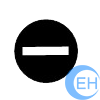Screw drive styles are a system used to turn a screw. At a minimum, screw drive styles are a feature on the screw that allows torque to be applied to it. Usually, it also involves a mating tool, such as a screwdriver, that is used to turn it. The following heads are categorized based on commonality, with the less common drives being classified as “tamper-resistant”. Ever Hardware provides custom made screws/bolts and customizable packaging.
Most heads come in a range of sizes, screw drive styles typically distinguished by a number, such as “Phillips #00” or “Torx T5.” These sizes do not necessarily describe a particular dimension of the drive shape but are often arbitrary designations in the same sense as a “Size 8” dress.
| Screw drive styles |
| Drive style |
Name |
Description |
 |
Allen |
The Allen screw drive also known as hex socket screw drive has a hexagonal recess and may be driven by a hex wrench, also known as an Allen wrench, Allen key, hex key, or inbus as well as by a hex screwdriver (also known as a hex driver) or bit. Tamper-resistant versions with a pin in the recess are available. |
 |
Phillips |
Phillips drive is the most used screw drive, Phillips bits are often designated by the letters “PH”, plus a size code 0000, 000, 00, 0, 1, 2, 3, or 4 (by order of increasing size); the numerical bit size codes do not necessarily correspond to nominal screw size numbers. |
 |
Pozidriv |
The Pozidriv is an improved version of the Phillips screw drive. Pozidriv was jointly patented by the Phillips Screw Company and American Screw Company. The name is thought to be a portmanteau of the words “positive” and “drive.” Its advantage over Phillips drives is its decreased likelihood to cam out, which allows greater torque to be applied. Pozidriv drive bits are often designated by the letters “PZ” plus a size code of 0, 1, 2, 3, 4, or 5 (by order of increasing size); the numerical bit size codes do not necessarily correspond to nominal screw size numbers. |
 |
Security |
Security screw drive has maximum torque transfer positive tool engagement means easier drive installation with less pressure & slippage. Torx Pin-Head offers a high degree of security & requires a matching driver bit. |
 |
Slotted |
The slot screw drive has a single slot in the fastener head and is driven by a “common blade” or flat-bladed screwdriver. It was the first type of screw drive to be developed, and for centuries it was the simplest and cheapest to make. The slotted screw is common in simple woodworking applications but is not often seen in applications where a power tool would be used because a power driver tends to slip out of the head, potentially damaging the surrounding material. |
 |
Square |
Square screw drive has a square-shaped socket in the screw head and a square protrusion on the tool. Both the tool and the socket have a slight taper. Originally to make the manufacture of the screws practical using cold forming of the heads, this taper provides two other advantages that have served to popularize the drive: it makes inserting the tool easier and tends to help keep the screw on the tooltip without the user needing to hold it there. |
 |
Torx |
Torx developed in 1967 by Camcar Textron, is the trademark for a type of screw head characterized by a 6-point star-shaped pattern. A popular generic name for the drive is a star, as in star screwdriver or star bits. The official generic name, standardized by the International Organization for Standardization as ISO 10664, is hexalobular internal. |
 |
Tri point |
The tri-point, security screw head is similar to the Phillips screw head, but it has three points rather than four. These specialized screws are usually used on electronics equipment, including the Nintendo GameCube, Nintendo Game Boy Advance, Game Boy Advance SP, Sanyo, and Kyocera cellular telephones and Fuji digital cameras. |
 |
Triangle |
The sides of the triangle are straight, which differs from TP3 fasteners. Sizes include TA14, TA18, TA20, TA23, and TA27. These screws are often found in children’s toys, particularly from fast-food restaurants. They can also be found in devices such as vacuum cleaners, fan heaters, elevators, camping stoves, Breville kettles, and Master Locks, among others, to help restrict access to the device internals. They can be driven with a flat head screwdriver, but with great difficulty. |









